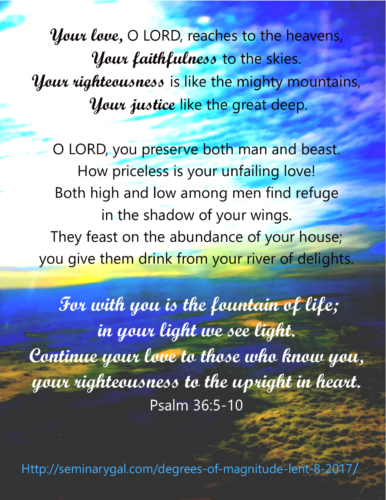Degrees of Magnitude (Lent 8, 2017)
Have you ever thought about your life in terms of degrees of magnitude … how abundant, how vast are your life characteristics of love, faithfulness, righteousness, and justice?
For God, they’re so big they can’t be measured and moreover, so amazing they can’t be contained. It is as a fountain of life, the magnitude of God’s light.
so big they can’t be measured and moreover, so amazing they can’t be contained. It is as a fountain of life, the magnitude of God’s light.
Psalm 36:5 Your love, O LORD, reaches to the heavens, your faithfulness to the skies. 6 Your righteousness is like the mighty mountains, your justice like the great deep. O LORD, you preserve both man and beast. 7 How priceless is your unfailing love! Both high and low among men find refuge in the shadow of your wings. 8 They feast on the abundance of your house; you give them drink from your river of delights. 9 For with you is the fountain of life; in your light we see light. 10 Continue your love to those who know you, your righteousness to the upright in heart.
This psalm is all about abundance and magnitude. In its totality, Psalm 36 is a study contrasting the most evil and the greatest good. The evil unrepentant ones in this world—whether great or small–end up in ruin. The ones with faith as small as a mustard seed have life.
What’s the point in giving it your all if even the tiniest faith can save? Does God value economy of effort or magnitude of love?
There’s a greater reward in heaven for giving it our all.
When we shine and reflect God’s love and faithfulness, righteousness and justice to other people, is it on again off again like an SOS to the world? Is it bright enough, light abundant enough to be truly read as the magnitude of love or is it just some light flashing on and off dimly in the night, hoping that someone can decode the message before disaster strikes?
Fun fact of light: Light intensity can be a matter of magnitude, vastness or quantity of light rays, plus how close they are to the source. The distance from the Earth to the Sun is not dramatically different even from season to season, let alone hour by hour. Of course, the Earth’s orbit is not a perfect circle, but more of an ellipse. Earth’s closest point of orbit is called the perihelion and in the Earth’s revolution, it happens in early January. At that point it is about 91 million miles from the Sun. At some point in early July, the Earth will be at its farthest from the Sun at approximately 94.5 million miles a mere 3.8% difference from its closest point.
So why do the rays of the Sun seem most intense in the early afternoon irrespective of season, but markedly so in the summer?
Well, there is the Earth’s shape—round—and therefore the Sun’s rays don’t fall on all parts of the planet equally. Places that face the Sun directly get sunlight from directly overhead, while places off to the side get sunlight at an angle. Therefore, the density of rays is less and the more atmosphere each ray must pass through before it reaches our eyes. The Earth’s axial tilt, rotation, and distance from the Sun all play a part in our light intensity at dawn, mid-day and dusk, hour by hour, and season by season.
For further thought:
- Why have increasing faith when even faith as small as a mustard seed can move mountains?
- How can we expect the world to see the magnitude of love that God has for us if our faith is only expressed as an SOS when we want God to bail us out?
- Thinking about light hitting the Earth, how can we orient ourselves to best receive God’s light and to display it with the greatest magnitude and consistency?
Thank you, Lord Jesus that You gave Your life so we might know the magnitude of the Father’s love. Help us to have faith that grows and not to settle for tiny faith on our timetable and kept in a drawer for when we think we need it. Help us to shine as Your light and be a city on a hill. We praise You for Your love! Amen.


Leave a Reply